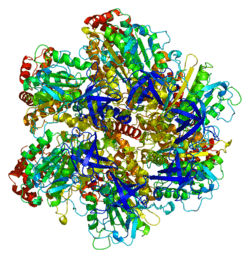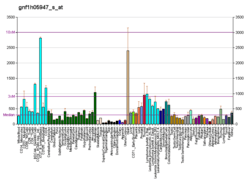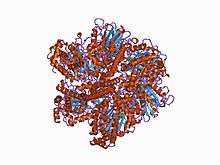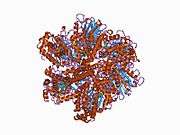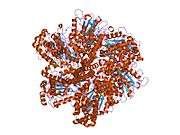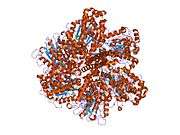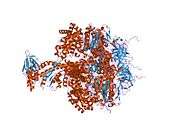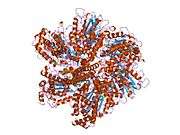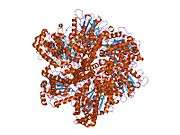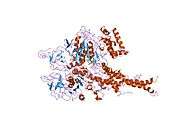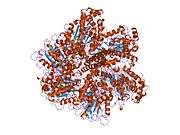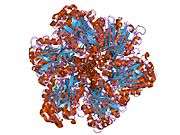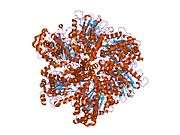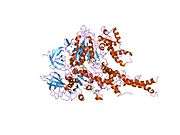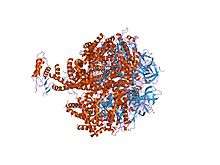ATP5B
ATP synthase subunit beta, mitochondrial is an enzyme that in humans is encoded by the ATP5B gene.[5][6]
Function
This gene encodes a subunit of mitochondrial ATP synthase. Mitochondrial ATP synthase catalyzes ATP synthesis, utilizing an electrochemical gradient of protons across the inner membrane during oxidative phosphorylation. ATP synthase is composed of two linked multi-subunit complexes: the soluble catalytic core, F1, and the membrane-spanning component, Fo, comprising the proton channel. The catalytic portion of mitochondrial ATP synthase consists of 5 different subunits (alpha, beta, gamma, delta, and epsilon) assembled with a stoichiometry of 3 alpha, 3 beta, and a single representative of the other 3. The proton channel consists of three main subunits (a, b, c). This gene encodes the beta subunit of the catalytic core.[6]
References
- 1 2 3 GRCh38: Ensembl release 89: ENSG00000110955 - Ensembl, May 2017
- 1 2 3 GRCm38: Ensembl release 89: ENSMUSG00000025393 - Ensembl, May 2017
- ↑ "Human PubMed Reference:".
- ↑ "Mouse PubMed Reference:".
- ↑ Neckelmann N, Warner CK, Chung A, Kudoh J, Minoshima S, Fukuyama R, Maekawa M, Shimizu Y, Shimizu N, Liu JD (Jan 1990). "The human ATP synthase beta subunit gene: sequence analysis, chromosome assignment, and differential expression". Genomics. 5 (4): 829–43. doi:10.1016/0888-7543(89)90125-0. PMID 2687158.
- 1 2 "Entrez Gene: ATP5B ATP synthase, H+ transporting, mitochondrial F1 complex, beta polypeptide".
External links
- Human ATP5B genome location and ATP5B gene details page in the UCSC Genome Browser.
Further reading
- Maguire D, Shah J, McCabe M (2007). "Assaying ATP synthase rotor activity". Adv. Exp. Med. Biol. Advances in Experimental Medicine and Biology. 578: 67–72. doi:10.1007/0-387-29540-2_11. ISBN 978-0-387-29543-5. PMID 16927672.
- Dawson SJ, White LA (1992). "Treatment of Haemophilus aphrophilus endocarditis with ciprofloxacin". J. Infect. 24 (3): 317–20. doi:10.1016/S0163-4453(05)80037-4. PMID 1602151.
- Ohta S, Kagawa Y (1986). "Human F1-ATPase: molecular cloning of cDNA for the beta subunit". J. Biochem. 99 (1): 135–41. PMID 2870059.
- Wallace DC, Ye JH, Neckelmann SN, Singh G, Webster KA, Greenberg BD (1988). "Sequence analysis of cDNAs for the human and bovine ATP synthase beta subunit: mitochondrial DNA genes sustain seventeen times more mutations". Curr. Genet. 12 (2): 81–90. doi:10.1007/BF00434661. PMID 2896550.
- Ohta S, Tomura H, Matsuda K, Kagawa Y (1988). "Gene structure of the human mitochondrial adenosine triphosphate synthase beta subunit". J. Biol. Chem. 263 (23): 11257–62. PMID 2900241.
- Villena JA, Martin I, Viñas O, Cormand B, Iglesias R, Mampel T, Giralt M, Villarroya F (1995). "ETS transcription factors regulate the expression of the gene for the human mitochondrial ATP synthase beta-subunit". J. Biol. Chem. 269 (51): 32649–54. PMID 7798271.
- Abrahams JP, Leslie AG, Lutter R, Walker JE (1994). "Structure at 2.8 A resolution of F1-ATPase from bovine heart mitochondria". Nature. 370 (6491): 621–8. doi:10.1038/370621a0. PMID 8065448.
- Elston T, Wang H, Oster G (1998). "Energy transduction in ATP synthase". Nature. 391 (6666): 510–3. doi:10.1038/35185. PMID 9461222.
- Wang H, Oster G (1998). "Energy transduction in the F1 motor of ATP synthase". Nature. 396 (6708): 279–82. doi:10.1038/24409. PMID 9834036.
- Moser TL, Stack MS, Asplin I, Enghild JJ, Højrup P, Everitt L, Hubchak S, Schnaper HW, Pizzo SV (1999). "Angiostatin binds ATP synthase on the surface of human endothelial cells". Proc. Natl. Acad. Sci. U.S.A. 96 (6): 2811–6. doi:10.1073/pnas.96.6.2811. PMC 15851. PMID 10077593.
- Wang ZG, White PS, Ackerman SH (2001). "Atp11p and Atp12p are assembly factors for the F(1)-ATPase in human mitochondria". J. Biol. Chem. 276 (33): 30773–8. doi:10.1074/jbc.M104133200. PMID 11410595.
- Andersen JS, Lyon CE, Fox AH, Leung AK, Lam YW, Steen H, Mann M, Lamond AI (2002). "Directed proteomic analysis of the human nucleolus". Curr. Biol. 12 (1): 1–11. doi:10.1016/S0960-9822(01)00650-9. PMID 11790298.
- Ackerman SH (2002). "Atp11p and Atp12p are chaperones for F(1)-ATPase biogenesis in mitochondria". Biochim. Biophys. Acta. 1555 (1–3): 101–5. doi:10.1016/S0005-2728(02)00262-1. PMID 12206899.
- Martinez LO, Jacquet S, Esteve JP, Rolland C, Cabezón E, Champagne E, Pineau T, Georgeaud V, Walker JE, Tercé F, Collet X, Perret B, Barbaras R (2003). "Ectopic beta-chain of ATP synthase is an apolipoprotein A-I receptor in hepatic HDL endocytosis". Nature. 421 (6918): 75–9. doi:10.1038/nature01250. PMID 12511957.
- Reuter TY, Medhurst AL, Waisfisz Q, Zhi Y, Herterich S, Hoehn H, Gross HJ, Joenje H, Hoatlin ME, Mathew CG, Huber PA (2003). "Yeast two-hybrid screens imply involvement of Fanconi anemia proteins in transcription regulation, cell signaling, oxidative metabolism, and cellular transport". Exp. Cell Res. 289 (2): 211–21. doi:10.1016/S0014-4827(03)00261-1. PMID 14499622.
- Cross RL (2004). "Molecular motors: turning the ATP motor". Nature. 427 (6973): 407–8. doi:10.1038/427407b. PMID 14749816.
- Aboulaich N, Vainonen JP, Strålfors P, Vener AV (2005). "Vectorial proteomics reveal targeting, phosphorylation and specific fragmentation of polymerase I and transcript release factor (PTRF) at the surface of caveolae in human adipocytes". Biochem. J. 383 (Pt 2): 237–48. doi:10.1042/BJ20040647. PMC 1134064. PMID 15242332.
- Jin J, Smith FD, Stark C, Wells CD, Fawcett JP, Kulkarni S, Metalnikov P, O'Donnell P, Taylor P, Taylor L, Zougman A, Woodgett JR, Langeberg LK, Scott JD, Pawson T (2004). "Proteomic, functional, and domain-based analysis of in vivo 14-3-3 binding proteins involved in cytoskeletal regulation and cellular organization". Curr. Biol. 14 (16): 1436–50. doi:10.1016/j.cub.2004.07.051. PMID 15324660.
